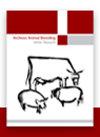长臂木霉产外源性纤维分解酶对橄榄渣瘤胃降解影响的体外研究
IF 1.6
3区 农林科学
Q2 AGRICULTURE, DAIRY & ANIMAL SCIENCE
引用次数: 9
摘要
摘要橄榄渣是一种低质量的饲料,由于其木质纤维素含量高,存在总多酚和缩合单宁等抗营养因子,蛋白质含量低,很少用于反刍动物营养。本体外研究使用长臂木霉在瘤胃营养中产生的外源性纤维分解酶对这种废物(粗橄榄饼、提取的橄榄饼和橄榄叶)进行估价。该添加剂的酶活性为每毫升1161单位内葡聚糖酶、每毫升113单位外葡聚糖酶和每毫升2267单位木聚糖酶。这种处理是通过在26℃的空调室中喷洒四种剂量的基质来进行的:0(对照)、1(低)、2(中)和4µLg-1µLg-2(高)干物质橄榄磨废料 ∘C代表12 h。对于粗橄榄饼,这种添加剂在高剂量下增加了14 % 纤维素和8 % 与对照组相比,12 h。因此,与对照相比,它在这个时期增加了干物质的溶解度和还原糖。在瘤胃培养时,高剂量的外源性纤维分解酶使直接可溶性部分和不溶性部分的气体产生量、不溶性组分的气体产生率和干物质降解率增加了26 %, 24的有机物降解性 %, 28的可代谢能量值 %, 微生物粗蛋白的生产 % 与对照组相比。对于橄榄叶,与对照相比,中等剂量的外源性纤维分解酶也可以水解半纤维素化合物,释放更少的糖,并增加干物质的溶解度 h。在体外培养时,培养基剂量使立即可溶和不可溶组分的气体产生量、不可溶组份的气体产生率、干物质降解率增加了13 %, 11的有机物降解性 %, 可代谢能量值乘以12 %, 12 % 与对照组相比。然而,最高剂量改变了不溶性组分的气体产量,并使微生物粗蛋白产量减少了6 % 与对照组相比。在相同的条件下,将外源性纤维分解酶应用于提取的橄榄蛋糕,对其化学成分和营养价值没有任何影响。这些结果清楚地表明,外源性纤维分解酶的有效性随培养废物的不同而不同。使用外源纤维分解酶提高粗橄榄饼和橄榄叶的营养价值,可以鼓励饲养者以低成本的动物营养将这些废物用作饲料。这种对废物的估价是一个很好的解决方案,可以减少将这些受污染的废物丢弃到环境中对土壤和地下水造成的污染。本文章由计算机程序翻译,如有差异,请以英文原文为准。
In vitro study on the effects of exogenic fibrolytic enzymes produced from Trichoderma longibrachiatum on ruminal degradation of olive mill waste
Abstract Olive mill waste is low-quality feed and rarely used in ruminant nutrition because of its high lignocellulose content, the existence of anti-nutritional factors such as total polyphenol and condensed tannin, and low protein contents. This in vitro research was conducted to valorize this waste (crude olive cake, extracted olive cake, and olive leaves) using an exogenous fibrolytic enzyme produced from Trichoderma longibrachiatum in ruminal nutrition. The enzymatic activity of this additive was 1161 units of endoglucanase per millilitre, 113 units of exoglucanase per millilitre, and 2267 units of xylanases per millilitre. This treatment was applied by spraying substrates with four doses: 0 (control), 1 (low), 2 (medium), and 4 µLg-1 µLg-1 (high) of dry matter olive mill waste in an air-conditioned room at 26 ∘C for 12 h before in vitro incubation. For the crude olive cake, this additive at high doses increased degradation of 14 % of cellulose and 8 % of hemicellulose compared with the control at 12 h before the in vitro incubation. Consequently, it increased dry matter solubility and reduced sugars at this period compared to the control. Upon ruminal incubation, the high dose of exogenous fibrolytic enzyme increased the gas production from the immediately soluble fraction and insoluble fraction, the rate of gas production for the insoluble fraction, the dry matter degradability by 26 %, the organic matter degradability by 24 %, the metabolizable energy value by 28 %, and the microbial crude protein production by 24 % compared with the control. For olive leaves, an exogenous fibrolytic enzyme at medium dosage can also hydrolyse the hemicellulose compound, release fewer sugars, and increase dry matter solubility compared with the control at 12 h before the in vitro incubation. Upon in vitro incubation, the medium dose increased the gas production from immediately soluble and insoluble fractions, the rate of gas production for the insoluble fraction, the dry matter degradability by 13 %, the organic matter degradability by 11 %, the metabolizable energy value by 12 %, and the microbial crude protein production by 12 % compared with the control. However, the highest dose altered the gas production from insoluble fractions and decreased microbial crude protein production by 6 % compared with the control. Under the same conditions, an exogenous fibrolytic enzyme applied to extracted olive cake did not produce any effect in the chemical composition and nutritional value. These results showed clearly that effectiveness of exogenous fibrolytic enzyme varied with incubated waste. Increasing the nutritional value of crude olive cake and olive leaves using an exogenous fibrolytic enzyme can encourage breeders to use this waste as feed at a low cost in animal nutrition. This valorization of waste is a good solution to reduce pollution of soils and groundwater caused by throwing out this polluted waste into the environment.
求助全文
通过发布文献求助,成功后即可免费获取论文全文。
去求助
来源期刊

Archiv Fur Tierzucht-Archives of Animal Breeding
农林科学-奶制品与动物科学
CiteScore
3.20
自引率
0.00%
发文量
41
审稿时长
18-36 weeks
期刊介绍:
Archives Animal Breeding is an open-access journal publishing original research papers, short communications, brief reports, and reviews by international researchers on scientific progress in farm-animal biology. The journal includes publications in quantitative and molecular genetics, genetic diversity, animal husbandry and welfare, physiology, and reproduction of livestock. It addresses researchers, teachers, stakeholders of academic and educational institutions, as well as industrial and governmental organizations in the field of animal production.
 求助内容:
求助内容: 应助结果提醒方式:
应助结果提醒方式:


